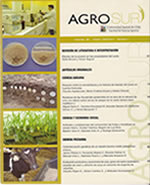Estrategias de engorde de vacas de descarte en sistemas pastoriles del Uruguay
Contenido principal del artículo
Resumen
El objetivo del estudio fue evaluar el efecto de diferentes niveles de oferta de forraje (NOF) de Avena bizantina cv. INIA Halley y la suplementación con afrechillo de arroz (AA) sobre el desempeño productivo y la calidad de la canal (in vivo) en vacas de descarte en Uruguay. El experimento se realizó durante 130 días (mayo-septiembre de 2013). Cuarenta vacas Hereford con un peso vivo (PV) de 480 ± 48,5 kg fueron asignadas a cuatro tratamientos (T) según NOF (2 y 4% PV) y AA (0,8 y 1,6% PV), dónde: T1 (NOF2), T2 (NOF4), T3 (NOF2+AA0,8) y T4 (NOF2+AA1,6). Los tratamientos no se diferenciaron (p > 0,05) en disponibilidad ni altura del forraje ofrecido. En el forraje remanente, T2 presentó mayor disponibilidad (p < 0,05) y altura (p < 0,01) y T1 los menores valores. El PV final (p < 0,05) y la ganancia diaria de peso fue inferior (p < 0,01) en T1 respecto de los otros tratamientos. La producción de kg PV ha-1 (p < 0,01) fue similar entre T3 y T4, superiores a T1 y T2 (similares entre sí). La eficiencia de conversión fue superior en T3 respecto a T4 (p < 0,01). El engrasamiento subcutáneo fue inferior en T2 respecto de los otros tratamientos (p < 0,01), sin presentar diferencias entre sí. El uso eficiente de cultivos anuales invernales y/o la suplementación estratégica en sistemas pastoriles permite mejorar el desempeño productivo y la calidad de la canal de vacas de descarte de la raza Hereford.

